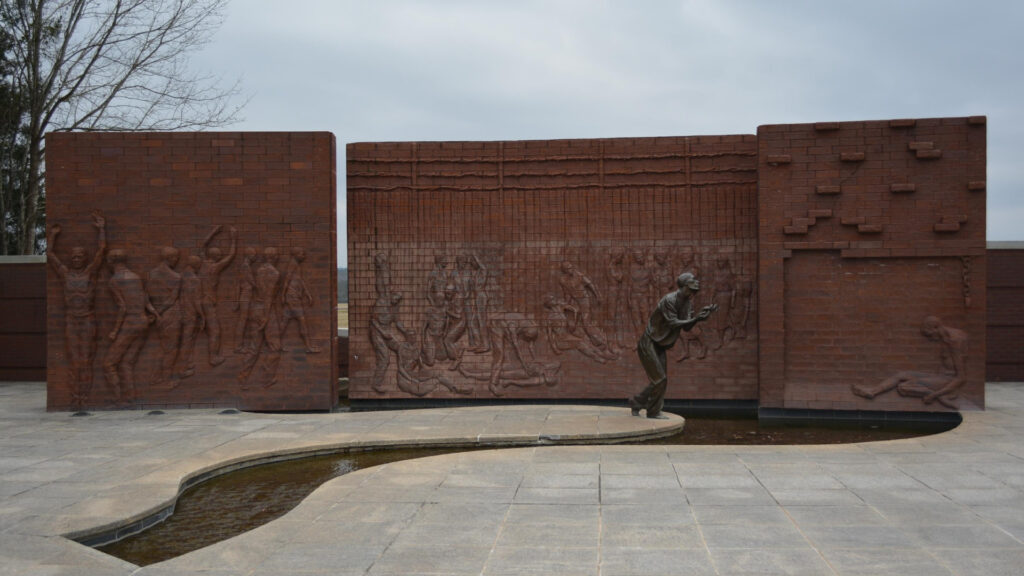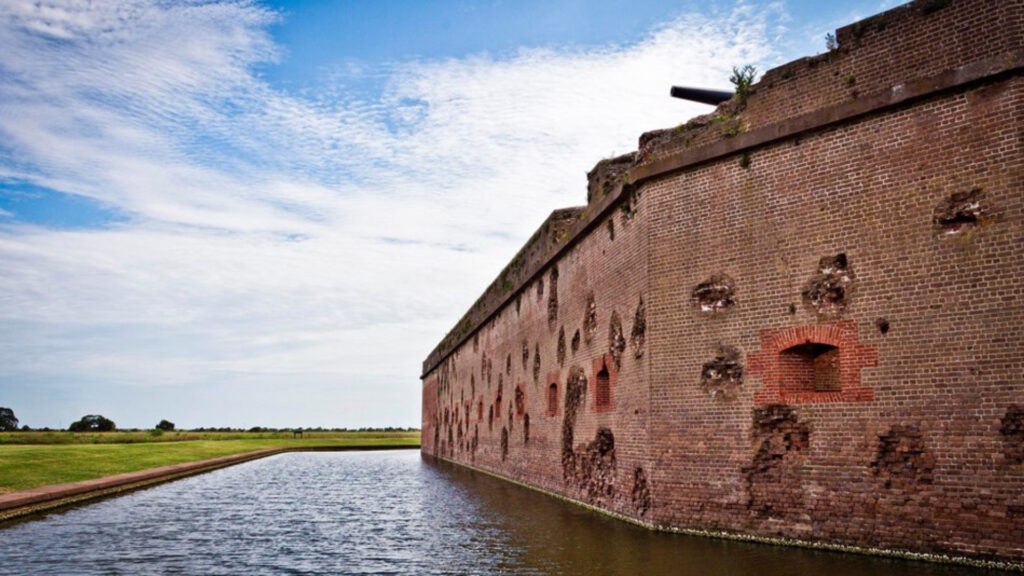Table of Contents Show
When planning a road trip to explore America’s National Parks, you probably think of visiting Utah, California, or Arizona. After all, most of the “big name” parks are out West.
Although there aren’t as many national parks on the country’s eastern side, don’t sleep on what’s in Georgia. They may not be as popular or highly trafficked.
However, with fewer crowds, you’ll be able to enjoy the beauty and learn about the history and culture of these places with ease.
Let’s learn more about the national parks in Georgia!
How Many National Parks Are In Georgia?
There are no national parks in the Peach State. But there are 12 locations with other National Park Service designations.
North of Atlanta, you’ll find the beginning of the Appalachian National Scenic Trail in Chattahoochee National Recreation Area.
You’ll also find part of the Trail of Tears National Historic Trail, and Kennesaw Mountain National Battlefield Park.
The Chickamauga and Chattanooga National Military Park stretches across the Georgia-Tennessee border in the northwest part of the state.
In the capital itself is the Martin Luther King, Jr National Historical Park.
The Ocmulgee Mounds National Historical Park, Andersonville National Historic Site, and Jimmy Carter National Historical Park are south of Atlanta.
Cumberland Island National Seashore, Fort Frederica National Monument, and Fort Pulaski National Monument are along the coast.
Pro Tip: If you’d like to learn more about the different National Park Service designations, you can read our article all about Decoding The National Park System!

National Park Designations in Georgia You Need to Visit
When heading into the Peach State, you’ll want to make plans to stop at each of these designated National Park areas.
Georgia has a rich history, and these locations preserve the past – good and bad.
That way, visitors can learn about Georgia and our nation’s history.
1. Andersonville National Historic Site
The Andersonville National Historic Site was built during the Civil War to hold Union Army prisoners captured by Confederate soldiers. Camp Sumpter holds 10,000 prisoners, but it actually kept 32,000 men confined here.
The conditions were deplorable, and almost 13,000 men died. They’re buried at the Andersonville National Cemetery on property.
Things to Do: Tour the Camp Sumpter military prison on foot or by car. The one-hour self-guided audio driving tour is free.
It covers 26.5 acres of the Andersonville National Historic Site. Guests can also visit the national cemetery, where nearly 20,000 people are laying to rest.
Before leaving, check out the national prisoner of War Museum, the only museum dedicated to interpreting the American prisoner of war experience.

2. Chattahoochee River National Recreation Area
Get away from the busyness of life and explore one of the best national parks in Georgia. It has 48 miles of river and 15 land units that makeup the Chattahoochee River National Recreation Area.
In 2012, the Chattahoochee River became the first trail to be designated as a national water trail. Boat launches and ramps, shoals, picnic shelters, biking trails, and hiking trails go throughout the park.
Things to Do: Whether you’re looking to float, fish, or bike, the Chattahoochee River National Recreation Area is an outdoor lover’s paradise.
Book a river float tour or bring your own canoe. Anglers enjoy casting their lines for trout, bass, and catfish.
There are over 7 miles of biking trails that run throughout the park. You won’t run out of things to do to enjoy nature at Chattahoochee River National Recreation Area.
3. Chickamauga & Chattanooga National Military Park
Chattanooga was known as the “Gateway to the Deep South” during the Civil War. If the Union could capture Chattanooga, they’d have control of the supply lines that ran through the Confederacy.
In 1863, Union General William Rosecrans threatened the Confederate Army from behind and sent the Confederates fleeing south.
Thousands died at the Battle of Chickamauga as the Confederates started losing control over their strongholds.
Things to Do: Follow history along the 80 miles of trails on foot in this national park in Georgia, by bike, or on horseback. Grab your kayak or canoe and paddle along two creeks within the park.
Visit the Lookout Mountain Battlefield and Point Park, book a car caravan tour, and explore the Chickamauga Battlefield with a park ranger.
Pro Tip: Do you want to visit all 63 National Parks? Use this free Map to Track Your Adventures!
4. Cumberland Island National Seashore
Cumberland Island is Georgia’s largest and southernmost barrier island. Over 9,800 acres of wilderness tell stories of Native Americans, missionaries, slaves, and Europeans.
Because it has remained mostly undeveloped, the land is constantly changing due to weather.
A rich ecosystem and biodiversity exist here. Wildlife sightings are quite common, with 18 miles of undeveloped beaches and over 36,000 acres of habitats.
Things to Do: Book The Lands and Legacies Tour and explore historic locations around the seashore, including Plum Orchard Mansion, the Settlement, Cumberland Island Wharf, and more.
More than 50 miles of trails meander through the forests, wetlands, and marshes.
Swimming, fishing, beachcombing, and biking are also popular outdoor activities along the Cumberland Island National Seashore.
5. Fort Frederica National Monument
When Georgia was first established, Britain and Spain claimed the land. But in 1742, Georgia defeated the Spanish, solidifying its place among the British colonies.
General Oglethorpe selected St. Simons Island for a new fortification to protect Georgia from further attacks by Spain. But the area was more than a military fort.
It was also a town where 1,000 people lived. However, when they no longer needed the military presence, Frederica became a ghost town.
In 1945, Fort Frederica National Monument came to be, and archaeological excavations began.
Things to Do: Join a park ranger for a guided tour or explore the fort on your own. You can reach the national monument by bike but can’t bike once you’ve arrived. There are parking areas for bicycles.
Learn about the local history by watching the film inside the visitor center and walking around the museum.
6. Fort Pulaski National Monument
During the Civil War, the Union Army blockaded Fort Pulaski so no supplies could go in or out. With the newest military technology – the rifled gun – Union Captain Quincy A. Gillmore began firing upon Fort Pulaski, and the Confederate troops surrendered.
Fort Pulaski was the model of the old way of military protection. After the Civil War, it was clear that new tactics to combat these new technologies were essential to the protection of America.
Things to Do: The North Pier Trail takes visitors through remnants of Fort Pulaski’s original construction village.
The Lighthouse Overlook Trail offers views of the Savannah River, Tybee Island, and the historic Cockspur Island Lighthouse.
At the visitor center, guests can watch the park film to learn more about the history of Fort Pulaski and walk through exhibits highlighting the significance of the 1862 battle.

7. Jimmy Carter National Historical Park
A visit to the Jimmy Carter National Historical Park in Plains, Ga., provides a look into the history and culture of this small Southern town and how President Carter’s upbringing led him to become the 39th President.
The park museum and visitor center are inside Plains High School, where guests can walk around various rooms to learn more about President Carter’s life while in Plains.
In 1976, the train depot became the presidential campaign headquarters and is now a museum that details this part of President Carter’s life.
Things To Do: Stroll through one of the most presidential national parks in Georgia as you walk President Carter’s boyhood farm and listen to audio excerpts as he shares stories about his childhood.
Visit the visitor center and train depot museum to learn more about President Carter and the Plains community.
Support local businesses in the downtown historic district or grab a bite of Southern cuisine.
Keep in Mind: Did you know that Georgia is also home to canyons? A hidden gem you may not know about is the Little Grand Canyon in Georgia!
8. Kennesaw Mountain National Battlefield Park
From June 19, 1864, until July 2, 1864, Kennesaw Mountain was the site of a Civil War battle that raged between the Union and the Confederacy.
However, Kennesaw Mountain National Battlefield Park preserves more than just military history. It also tells about the culture and people of Kennesaw Mountain.
Learn about the Cherokee people and how Europeans forced them out of their homeland.
Things To Do: When you arrive at this national park in Georgia, start your visit by watching the park film to learn more about the site.
Then walk around the museum exhibits to see artifacts telling the Atlanta Campaign story.
Check the calendar for living history programs and ranger-led tours of the battlefield. If you want to explore on your own, there are 22 miles of trails to hike, or you can drive to the top of Kennesaw Mountain.
9. Martin Luther King, Jr. National Historical Park
The Martin Luther King Jr. National Historical Park is one of Atlanta’s top tourist destinations. Here you will learn not only about the role Martin Luther King, Jr. played in the Civil Rights Movement but also the roles of the not-so-famous heroes.
From King’s birth home to his final resting place, you’ll leave this park inspired to work for change and equality.
Things To Do: At the Martin Luther King Jr. National Historical Park, guests can take a ranger-led tour of King’s birth home, learn about the desegregation of the Atlanta Fire Department, and meander through the beautiful “I Have A Dream” World Peace Rose Garden.
Visitors can also see Ebenezer Baptist Church, where King and his father were ordained as pastors. Guests can also pay their respects at the final resting place of King and his wife at The King Center.

10. Ocmulgee Mounds National Historical Park
A prehistoric American Indian site, the Ocmulgee Mounds National Historical Park preserves the many American Indian cultures that have called this land “home” for thousands of years.
Between 1933 and 1936, over 800 men conducted the largest archeological dig in American history here.
They discovered hundreds of thousands of artifacts, such as pottery, arrowheads, stone tools, and jewelry. Guests can see some of these artifacts in the Ocmulgee Mounds National Historical Park’s museum.
Things To Do: Eight miles of trails lead visitors to seven different mounds where you can dial a number to hear information about each site.
One of the stops will be at the Earth Lodge, a reconstructed council chamber of the Mississippian culture. As you enter, you’ll be stepping on the original clay floor that’s over 1,000 years old.
Visitors will also want to watch the 17-minute park film and explore the museum at the visitor center.
Don’t Forget the National Trails in Georgia
The Trail of Tears National Historic Trail runs through nine states: Alabama, Arkansas, Georgia, Illinois, Kentucky, Missouri, North Carolina, Oklahoma, and Tennessee.
This trail commemorates the survival of the Cherokee people, forcefully removed from their homelands in the 1830s.
You’ll find the trail running through Georgia from the Chattahoochee River National Recreation Area north and east. Along the trail, visitors can participate in educational programs.
The second national trail in Georgia is the Appalachian National Scenic Trail. Whereas the Trail of Tears is a historic trail, the Appalachian Trail captures the beauty of the Eastern mountain range of America.
This 2,180-mile-long public footpath runs from Georgia to Maine. Private citizens built and completed it in 1937. Today it’s a bucket list hike for many outdoor enthusiasts.
When Is the Best Time to Visit the National Parks In Georgia?
Georgia is one of the few states that enjoys mild weather all year. You can visit the National Parks in Georgia anytime without fearing closures or harsh weather.
However, summers can be hot, humid, and crowded, so if you can avoid that time of year, you’ll be able to enjoy fewer people and pleasant temperatures.
Don’t Miss These National Parks in the Peach State
Georgia may not be known for its National Parks. Instead, you may think of historic cities like Savannah or Macon or imagine hundreds of acres of peach farms.
But if you skip out on visiting the national parks in Georgia, you’re missing out on learning about critical eras in our nation’s history. Help preserve the culture by planning a road trip to visit some of these sites.
Where will your Georgia journey begin?






